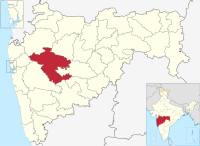Related Research Articles

The Ochre Coloured Pottery culture (OCP) is a Bronze Age culture of the Indo-Gangetic Plain "generally dated 2000–1500 BCE," extending from eastern Punjab to northeastern Rajasthan and western Uttar Pradesh.
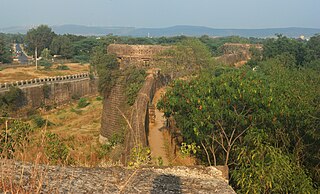
Ahmednagar district is the largest district of Maharashtra state in western India. The historical Ahmednagar city is the headquarters of the district. Ahmednagar and Sangamner are largest cities in the district. Ahmednagar was the seat of the Ahmednagar Sultanate of late medieval period. This district is known for the towns of Shirdi associated with Sai Baba, Meherabad associated with Meher Baba, Shani Shinganapur with Shanidev, and Devgad with Lord Dattatreya. Ahmednagar district is part of Nashik Division. The district is bordered by Aurangabad district to the northeast, Nashik district to the northwest, Thane and Pune districts to the southwest, Solapur district to the south and Beed district to the southeast.

Sangamner is a city and a municipal council located in the Ahmednagar District of Maharashtra state in India. Situated on the Pravara River, it derives its name from the site of the sangam (confluence) of three rivers in the area: Pravara, Mhalungi, and Adhala.

Pottery in the Indian subcontinent has an ancient history and is one of the most tangible and iconic elements of Indian art. Evidence of pottery has been found in the early settlements of Lahuradewa and later the Indus Valley Civilization. Today, it is a cultural art that is still practiced extensively in Indian subcontinent. Until recent times all Indian pottery has been earthenware, including terracotta.

In the archaeology of Southwest Asia, the Late Neolithic, also known as the Ceramic Neolithic or Pottery Neolithic, is the final part of the Neolithic period, following on from the Pre-Pottery Neolithic and preceding the Chalcolithic. It began around 6,400 BCE in the Fertile Crescent, succeeding the period of the Pre-Pottery Neolithic. By then distinctive cultures emerged, with pottery like the Halafian and Ubaid. This period has been further divided into PNA and PNB at some sites.
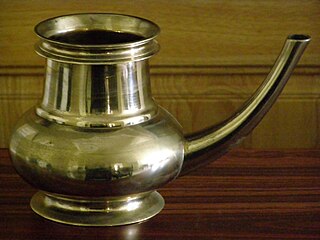
Kindi is a type of a pitcher usually found in old houses in Kerala and other parts of India.

The Ahar culture, also known as the Banas culture is a Chalcolithic archaeological culture on the banks of Ahar River of southeastern Rajasthan state in India, lasting from c. 3000 to 1500 BCE, contemporary and adjacent to the Indus Valley Civilization. Situated along the Banas and Berach Rivers, as well as the Ahar River, the Ahar–Banas people were exploiting the copper ores of the Aravalli Range to make axes and other artefacts. They were sustained on a number of crops, including wheat and barley.

Daimabad is a deserted village and an archaeological site on the left bank of the Pravara River, a tributary of the Godavari River in Shrirampur taluka in Ahmednagar district of Maharashtra state in India. This site was discovered by B. P. Bopardikar in 1958. It has been excavated three times so far by the Archaeological Survey of India teams. The first excavation in 1958-59 was carried out under the direction of M. N. Deshpande. The second excavation in 1974-75 was led by S. R. Rao. Finally, the excavations between 1975-76 and 1978-79 were carried out under the direction of S. A. Sali. Discoveries at Daimabad suggest that Late Harappan culture extended into the Deccan Plateau in India. Daimabad is famous for the recovery of many bronze goods, some of which were influenced by the Harappan culture.

Vijay Bhausaheb Thorat is an Indian politician currently serving as minister for revenue in Maharashtra state. He is an Indian National Congress legislator from Sangamner constituency.
Madhukar Keshav Dhavalikar was an Indian historian and archaeologist.

Ghod River is located in Pune District, Maharashtra, western India. It is a tributary of the Bhima River. The Ghod originates on the eastern slopes of the Western Ghats at 1,090 metres (3,580 ft) above sea level. It flows in an east-southeast direction for approximately 200 kilometres (120 mi) before its confluence with the Bhima. It flows from the northern side of the Sahyadri Hills.

Inamgaon is a post-Harappan agrarian village and archaeological site located in Maharashtra, western India. Situated along the right bank of the Ghod River, it is considered to be the 'regional centre' of the Bhima Valley.

The stone circles of Junapani are prehistoric megalithic circles in Junapani, near Nagpur in the Indian state of Maharashtra. There are about 300 such stone circles noted around Junapani. They were first excavated by J. H. Rivett-Carnac in 1879, yielding a variety of iron objects including daggers, flat axes with cross-ring fasteners, hoes, rings, bracelets, horse bits, chisels with long blades, and pointed tongs, possibly covered with a wooden handle. There is also evidence of black and red pottery, such as bowls featuring linear paintings in black. The burial sites were characterized by cairns. About 150 stone circles have been studied and documented. A notable feature is the cup-marked stones in the circles which seem to suggest an astronomical significance. This aspect has been discerned from the fact that the cup-marked stones are fixed at specific locations denoting specific directions.

Hasmukh Dhirajlal Sankalia was an Indian Sanskrit scholar and archaeologist specialising in proto- and ancient Indian history. He is considered to have pioneered archaeological excavation techniques in India, with several significant discoveries from the prehistoric period to his credit. Sankalia received the Ranjitram Suvarna Chandrak award in 1966. And also received Padma Bhushan in the year 1974.
Pandurang Gamaji Abhang is the President of ‘Deenmitrakar’ Mukundrao Patil Smarak Samiti.
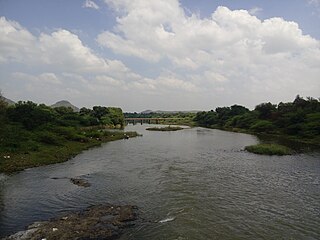
Chandoli Budruk is a village in Ambegaon Taluka of Pune district in the Indian state of Maharashtra. According to 2011 Census the population of Chandoli Budruk is 3,546 out of which 1,777 are male and 1,769 are females. There are total 692 houses in Chandoli Budruk. The GP Code of Chandoli Budruk is 185274 and PIN Code is 410 503.
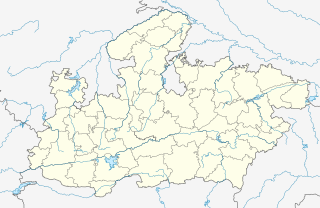
Kaytha or Kayatha is a village and an archaeological site in the Ujjain district of Madhya Pradesh, India, in the Tarana tehsil, near the city of Ujjain, on the banks of Choti-Kali Sindh river. It is an archeologically and mythologically important village where several excavations have revealed cultures dating back to more than 4000 years, also said to be the birthplace of Chitragupt, a Hindu deity, in Southern scriptures and of Varahamihira, an ancient Indian astronomer. The archeologically important Kayatha culture was discovered by V. S. Wakankar in 1964

The Malwa culture was a Chalcolithic archaeological culture which existed in the Malwa region of Central India and parts of Maharashtra in the Deccan Peninsula. It is mainly dated to c. 1600 – c. 1300 BCE, but calibrated radiocarbon dates have suggested that the beginning of this culture may be as early as c. 2000-1750 BCE.

The Jorwe culture was a Chalcolithic archaeological culture which existed in large areas of what is now Maharashtra state in Western India, and also reached north into the Malwa region of Madhya Pradesh. It is named after the type site of Jorwe. The early phase of the culture is dated to c. 1400-1000 BCE, while the late phase is dated to c. 1000-700 BCE.

Navdatoli refers to both a modern day village and a chalcolithic era settlement located on the Narmada River in Madhya Pradesh in central India. The ancient village was inhabited through four stages each defined by distinctly different types of pottery. The site was excavated between 1957 and 1959 over two seasons. Both the village and the site are located roughly a mile south of the modern day town of Maheshwar.
References
- ↑ Dhavalikar, M. K. (1985). "Genesis of the Jorwe Culture". In S. B. Deo; M. K. Dhavalikar (eds.). Studies in Indian Archaeology. Bombay: Popular Prakashan. pp. 32–41. ISBN 0-86132-088-3.
- ↑ "Jorwe culture, a Chalcolithic culture, was first discov - GKToday".
- 1 2 Deshpande, M.N (1970–71). "Indian Archaeology 1970-71 -A Review" (PDF). Indian Archaeology Review.
- 1 2 Ghosh, A. (1953–54). "Indian Archaeology 1953-54-A Review" (PDF). Indian Archaeology- A Review.
